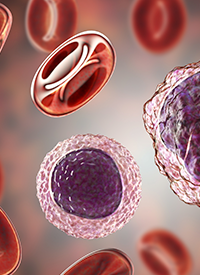Commentary
Article
Later-Line Ruxolitinib Use Produces Ongoing Benefit in Real-World Patients With cGVHD
Author(s):
Real-world ruxolitinib use in chronic GVHD was primarily in the second- or third-line, lasted for a median of 8 months, and involved dose adjustments.
Hematology - stock.adobe.com

The majority of pediatric and adult patients with chronic graft-vs-host disease (cGVHD) received ruxolitinib (Jakafi) as a monotherapy or in combination with calcineurin inhibitors following treatment with corticosteroids, with one-third of patients deriving benefit from continued, dose-adjusted ruxolitinib treatment for a median duration of over 1 year, according to data from a real-world, retrospective study of insurance claims presented at the 2024 Transplantation & Cellular Therapy Meetings.1
The retrospective study of 471 adult and pediatric patients showed that 58.4% of patients who refilled their medication required dose adjustments, 55.9% of which were dose increases and 44.1% were dose decreases as the first dose change. The median time to dose change was 82 days.
“In real-world clinical practice, ruxolitinib was generally given after corticosteroids in both pediatric and adult patients with cGVHD,” investigators stated in their poster. “However, there was some first-line use of ruxolitinib.”
cGVHD can occur following allogeneic hematopoietic cell transplantation (alloHCT) and is potentially life-threatening. Ruxolitinib is generally used to treat patients with cGVHD in the second or third line following progression on systemic therapy.
In the phase 3 REACH3 trial (NCT03112603), patients with cGVHD who received 10 mg ruxolitinib twice daily had an overall response rate of 49.7% at week 24 compared with 25.6% in patients who received investigator’s choice of therapy. Ruxolitinib also demonstrated longer median failure-free survival and higher symptom response.2
At the final analysis at 3-year follow-up of the REACH3 trial, median duration of response was not reached in the ruxolitinib arm and the probability of maintaining duration of response at 3 years was 59.6% in the ruxolitinib arm vs 26.7% in the best available therapy arm.3 Adverse events (AEs) led to dose adjustment or interruption in 32.7% of patients in the ruxolitinib arm vs 9.5% in the best available therapy arm.
The investigators who presented the poster stated that real-world data on the treatment patterns of ruxolitinib use in cGVHD was needed.1 The study utilized the closed-claims segment of the Komodo Healthcare Map, which included health plan members of commercial, Medicare and Medicare Advantage, and Medicaid who received alloHCT and were diagnosed with cGVHD between January 1, 2019, and November 30, 2022. Patients were included if they submitted at least 1 insurance claim for ruxolitinib and had at least 6 months of health insurance coverage before and after the index date. Patients were followed for a median of 465 days (IQR, 316-694) from initiation of ruxolitinib.
The mean age of the patients was 42.6 years; 15.3% were under 18 years old and 10.6% were over 65 years old. During the study period, 74.1% reported at least 1 claim for acute GVHD. Although the majority of the overall patient population (59.2%) had commercial insurance, 66.7% of the pediatric patients had Medicaid. The median baseline Charlson Comorbidity Index score was 2.0 (IQR, 2.0-4.0). The most common comorbidities included anemia (77.7%); nutritional, endocrine, or metabolic disorders (72.4%); skin disorders (72.0%); lower respiratory disease (69.2%); and gastrointestinal disorders (69.0%).
Of the 471 patients, 175 (37.2%) initiated therapy from 2019 to 2020, and 296 (62.9%) initiated therapy from 2021 to 2022. Ruxolitinib was given as monotherapy in 43.1% and in combination with calcineurin inhibitors in 37.2% following treatment with corticosteroids. Other combinations included ruxolitinib with mTOR inhibitor, with mycophenolate mofetil, or with rituximab (Rituxan).
Ruxolitinib was most commonly given in the second line (45%), followed by 31% in the third line, 11% in the fourth, 5% in the fifth, and 3% in the sixth. It was given in the first line in 5% of patients. Patients started receiving ruxolitinib after a median of 116 days from cGVHD diagnosis. In the 6 months prior to initiating ruxolitinib, 88.3% of patients had at least 1 corticosteroid prescription filled, and 76.0% received calcineurin inhibitors.
The median starting dose was 10 mg daily (IQR, 5-10) in pediatric patients and 10 mg daily (IQR, 10-20) in adult patients. In addition to dose changes, the types of changes to index ruxolitinib line of therapy were tracked; these included discontinuation in 48.8%, switch in 17.0%, add-on in 15.7%, end of study period in 16.4%, and death in 2.1%.
The median time to discontinuation (TTD) was 245 days (95% CI, 210-300). The median TTD was 286 days for pediatric patients and 243 days in adult patients, with no statistical difference (P = .918). TTD was also similar between insurance types (P = .162): 270 days with commercial insurance, 210 days with Medicare, 239 days with Medicaid, and 123 days with multiple types. TTD did not differ significantly by index year (P = .026): 243 days for 2019, 285 days for 2020, 202 days for 2021, and not estimable for 2022.
At the end of follow-up, 33.1% of patients remained on ruxolitinib treatment, for a median duration of treatment of 389 days (IQR, 260-591). The investigators concluded that these patients in real-world are receiving ruxolitinib for a median of approximately 8 months and approximately one-third are deriving ongoing clinical benefit for over 1 year. Most patients appeared to be able to receive it at the recommended dose level and continue treatment successfully with the support of dose adjustments.
References
- Yu J, Moore KJ, Engel-Nitz N, Ducharme M, Galvin J, Bhatt V. Real-world characteristics and ruxolitinib treatment patterns in 471 patients with chronic graft-versus-host disease in the United States. Poster presented at: 2024 Transplantation and Cellular Therapies Meeting; San Antonio, TX; February 21-24, 2024. Abstract 385.
- Zeiser R, Polverelli N, Ram R, et al. Ruxolitinib for glucocorticoid-refractory chronic graft-versus-host disease. N Engl J Med. 2021;385(3):228-238. doi:10.1056/NEJMoa2033122
- Zeiser R, Russo D, Ram R, et al. Ruxolitinib in patients with chronic graft-versus-host disease: 3-year final analysis of efficacy and safety from the phase III REACH3 study. Blood. 2023;142(suppl_1):654. doi:10.1182/blood-2023-172590









